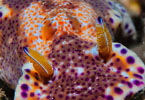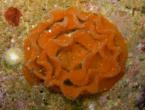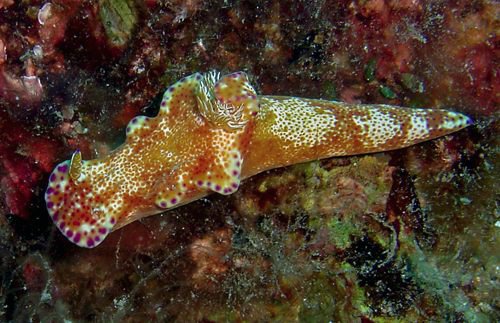_______________
Additional Photos

side

rhinophores

gills

yellow-orange

dark

young, 8 mm

regeneration error

feeding

missing
"horn"

with shrimp

mating

egg mass
_______________
GALLERY

|
Ceratosoma tenue Abraham, 1876

Maximum size: 97 mm.
Identification:
This species ranges from yellow-orange to deep maroon
blotched with cream
and overlain with violet spots that become larger marginally. The
branchia and rhinophores are orange lined with white. It is easily
recognized by its unusual
shape. The rigid body is
high and elongate with three characteristic mantle lobes along each
side. Even more conspicuous, the posterior end of the mantle occurs
about midway along the body forming a prominent, curved "horn" just
behind the gills.
Natural history:
A moderately common species, Ceratosoma
tenue is occasionally seen in moderately exposed to
exposed rocky habitats in as little as 0.5 m (1.5 ft). However, it
is most common in rocky habitats at depths of 15-40 m (49-131 ft). It
has also
been recorded from rocks in Halimeda
kanaloana
beds. Mature animals are diurnally active and feed on a blue sponge in
the genus Dysidea.
The mantle
glands, which contain chemicals obtained from sponges and distasteful
to fish, are concentrated in the large "horn." A fish nipping off the
protuberance may "expect" the entire animal to taste this way and leave
the rest of it intact. Animals with damaged or missing "horns" and
intact bodies support this hypothesis. The defense is not foolproof,
however, as some C. tenue
have been found in the stomachs of large fish that swallow their prey
whole (Rudman 1988). It is one of the dorids that occasionally hosts
the commensal shrimp, Zenopontonia rex (= Periclimenes imperator). (Hoover, 1998) It lays a frilly, orange egg mass of three or four whorls.
Distribution:
Big Island, Maui, Oahu, Kauai, Niihau and French Frigate Shoals: widely distributed in the
Indo-Pacific.
Taxonomic notes:
This is the species that Kay, 1979 as well as Kay & Young, 1969 list as Ceratosoma cornigerum
Adams and
Reeve, 1848. The name means slender. It is referred to as the
"kangaroo nudibranch" in Hoover, 1998 & 2006. It was first reported
in Hawaii from off Barber's Point, Oahu, in Jan., 1965 (Kay &
Young, 1969).
Photo: PF:
62 mm: Makena, Maui; August 11, 2008.
Observations and comments:
Note
1: ( )
|
|













